한국응용과학기술학회 논문 검색
.jpg)
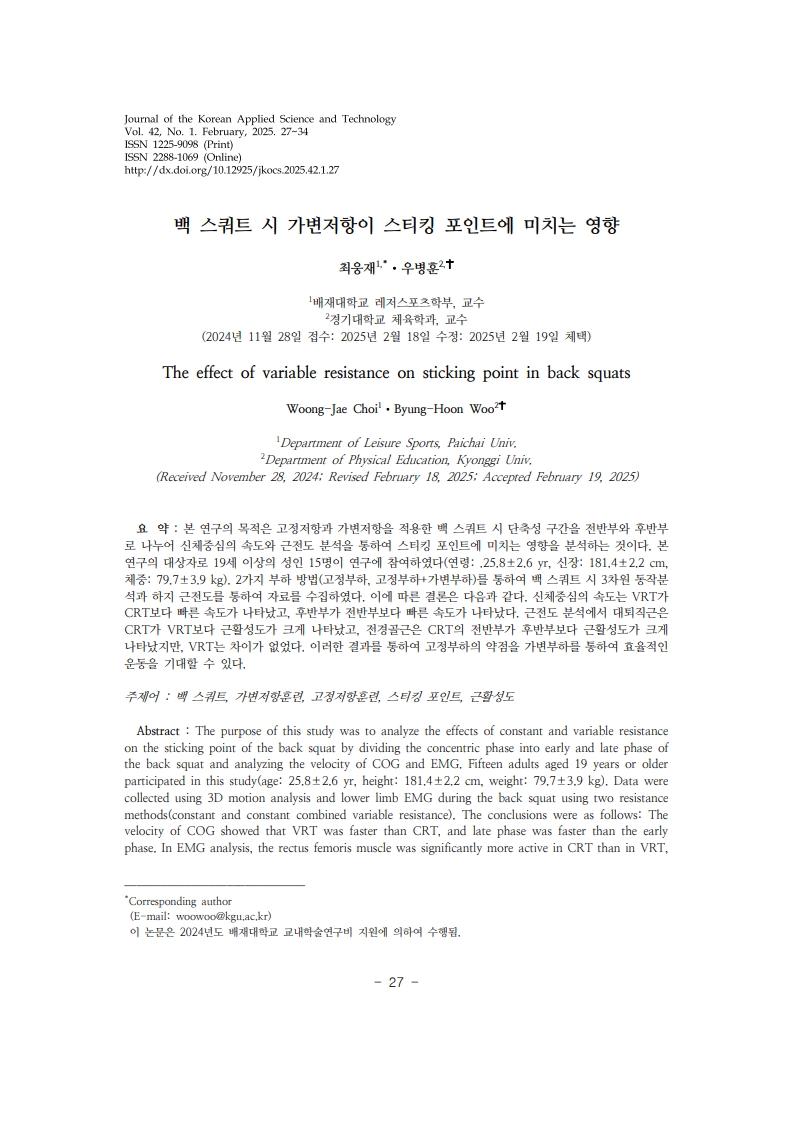

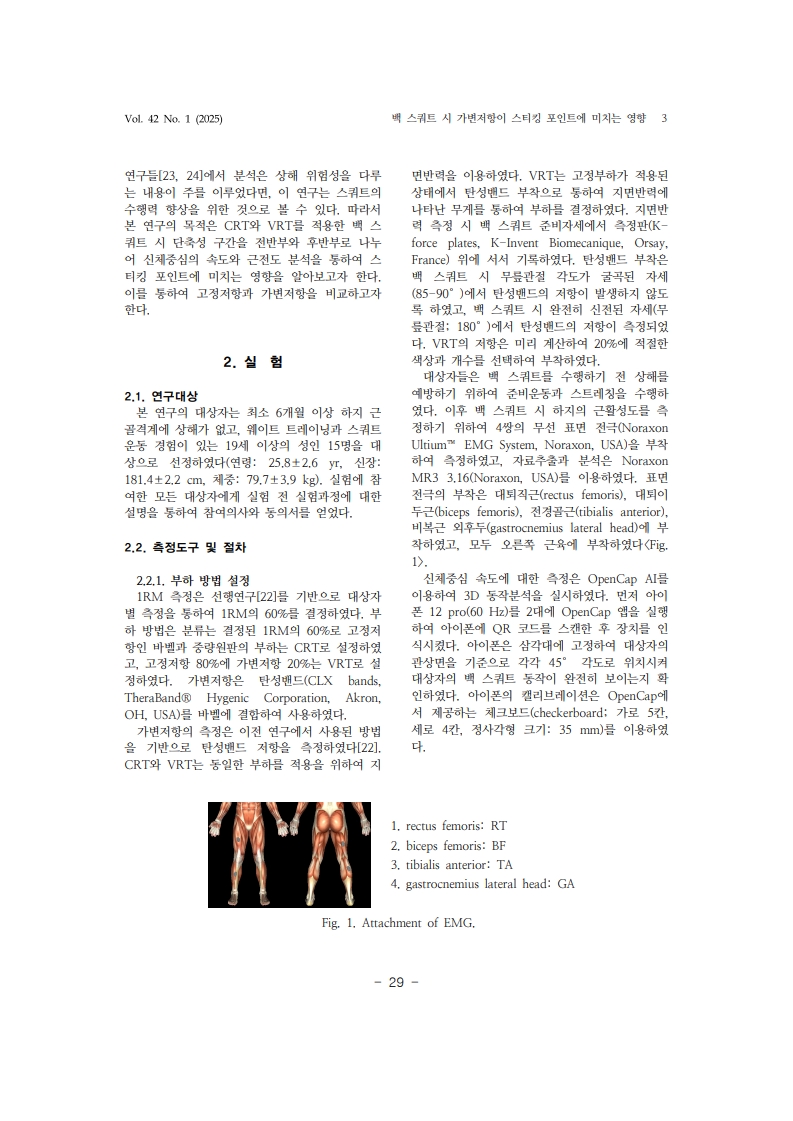
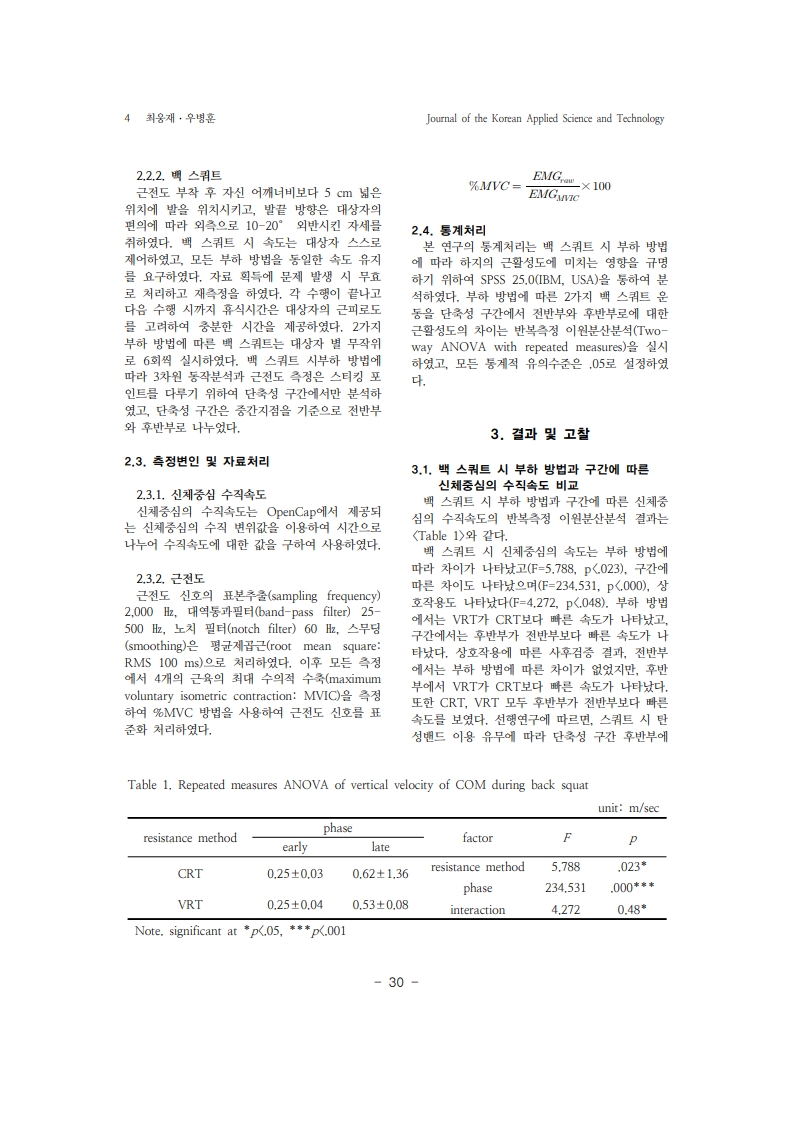

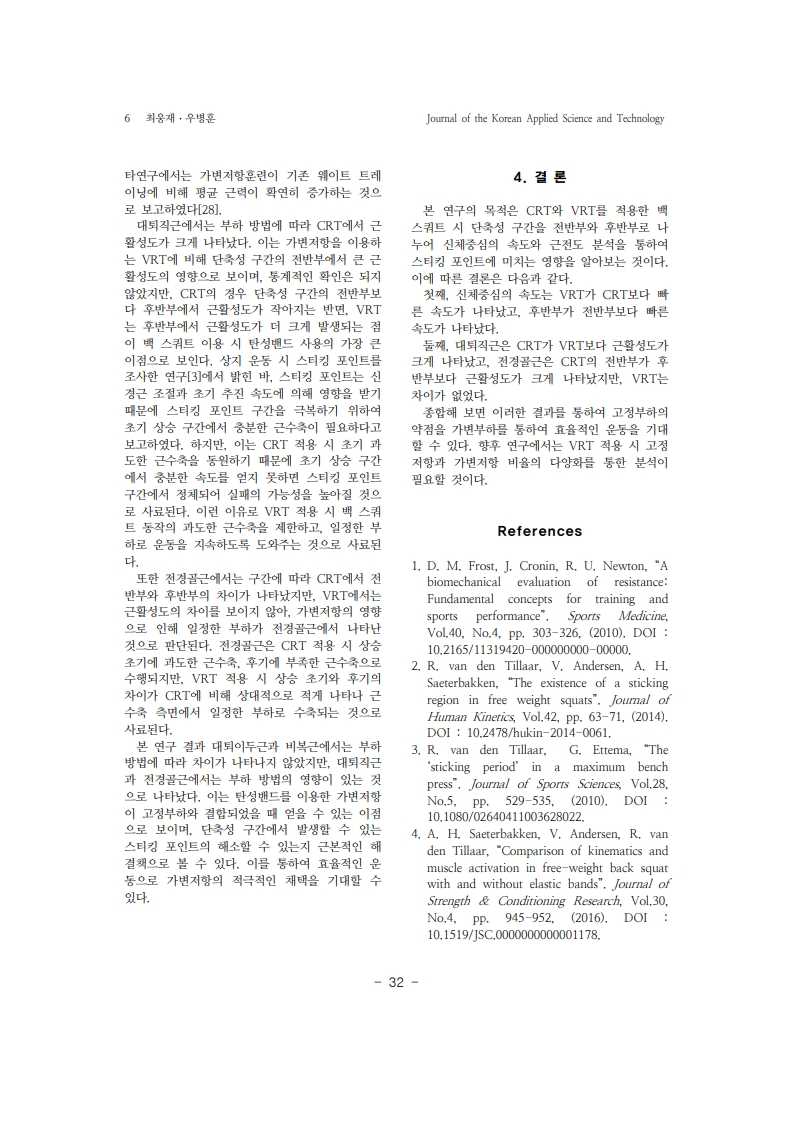
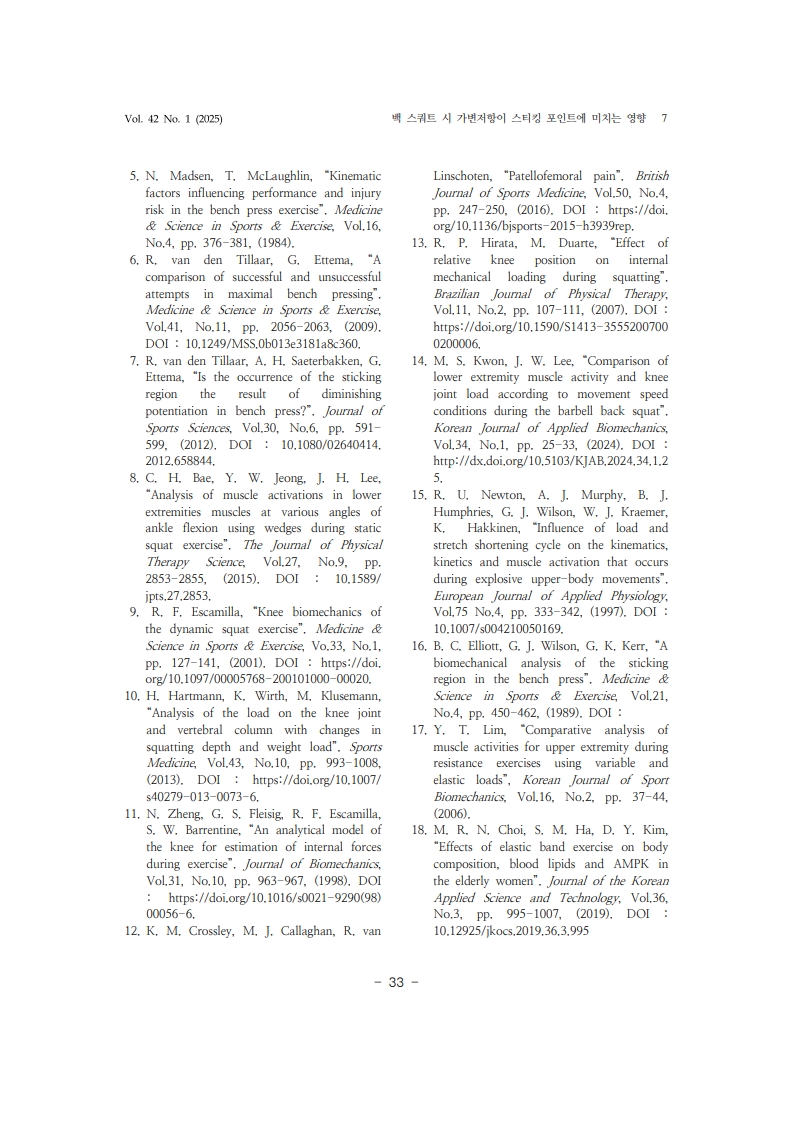
1. D. M. Frost, J. Cronin, R. U. Newton, “A biomechanical evaluation of resistance:Fundamental concepts for training and sports performance”. Sports Medicine, Vol.40, No.4, pp. 303-326, (2010).https://doi.org/10.2165/11319420-000000000-00000.
2. R. van den Tillaar, V. Andersen, A. H. Saeterbakken, “The existence of a sticking region in free weight squats”. Journal ofHuman Kinetics, Vol.42, pp. 63-71, (2014).
https://doi.org/10.2478/hukin-2014-0061.
3. R. van den Tillaar, G. Ettema, “The ‘sticking period’ in a maximum benchpress”. Journal of Sports Sciences, Vol.28, No.5, pp. 529-535, (2010).
https://doi.org/10.1080/02640411003628022.
4. A. H. Saeterbakken, V. Andersen, R. van den Tillaar, “Comparison of kinematics and muscle activation in free-weight back squat with and without elastic bands”. Journal of Strength & Conditioning Research, Vol.30, No.4, pp. 945-952, (2016).https://doi.org/10.1519/JSC.0000000000001178
5. N. Madsen, T. McLaughlin, “Kinematic factors influencing performance and injury risk in the bench press exercise”. Medicine & Science in Sports & Exercise, Vol.16, No.4, pp. 376-381, (1984).
6. R. van den Tillaar, G. Ettema, “A comparison of successful and unsuccessfulattempts in maximal bench pressing”. Medicine & Science in Sports & Exercise, Vol.41, No.11, pp. 2056-2063, (2009).https://doi.org/10.1249/MSS.0b013e3181a8c360.
7. R. van den Tillaar, A. H. Saeterbakken, G. Ettema, “Is the occurrence of the sticking region the result of diminishing potentiation in bench press?”. Journal of Sports Sciences, Vol.30, No.6, pp. 591- 599, (2012).https://doi.org/10.1080/02640414.2012.658844.
8. C. H. Bae, Y. W. Jeong, J. H. Lee, “Analysis of muscle activations in lowerextremities muscles at various angles of ankle flexion using wedges during static
squat exercise”. The Journal of Physical Therapy Science, Vol.27, No.9, pp.2853-2855, (2015).https://doi.org/10.1589/jpts.27.2853.
9. R. F. Escamilla, “Knee biomechanics of the dynamic squat exercise”. Medicine &Science in Sports & Exercise, Vo.33, No.1, pp. 127-141, (2001).
https://doi.org/10.1097/00005768-200101000-00020.
10. H. Hartmann, K. Wirth, M. Klusemann, “Analysis of the load on the knee jointand vertebral column with changes in squatting depth and weight load”. Sports
Medicine, Vol.43, No.10, pp. 993-1008, (2013) https://doi.org/10.1007/s40279-013-0073-6.
11. N. Zheng, G. S. Fleisig, R. F. Escamilla, S. W. Barrentine, “An analytical model of the knee for estimation of internal forces during exercise”. Journal of Biomechanics, Vol.31, No.10, pp. 963-967, (1998).https://doi.org/10.1016/s0021-9290(98)00056-6.
12. K. M. Crossley, M. J. Callaghan, R. van Linschoten, “Patellofemoral pain”. British Journal of Sports Medicine, Vol.50, No.4, pp. 247-250, (2016).
https://doi.org/10.1136/bjsports-2015-h3939rep.
13. R. P. Hirata, M. Duarte, “Effect of relative knee position on internalmechanical loading during squatting”. Brazilian Journal of Physical Therapy, Vol.11, No.2, pp. 107-111, (2007).https://doi.org/10.1590/S1413-35552007000200006.
14. M. S. Kwon, J. W. Lee, “Comparison of lower extremity muscle activity and knee joint load according to movement speed conditions during the barbell back squat”. Korean Journal of Applied Biomechanics, Vol.34, No.1, pp. 25-33, (2024). http://dx.doi.org/10.5103/KJAB.2024.34.1.2
5. 15. R. U. Newton, A. J. Murphy, B. J. Humphries, G. J. Wilson, W. J. Kraemer,K. Hakkinen, “Influence of load and stretch shortening cycle on the kinematics,
kinetics and muscle activation that occurs during explosive upper-body movements”. European Journal of Applied Physiology, Vol.75 No.4, pp. 333-342, (1997). https://doi.org/10.1007/s004210050169.
16. B. C. Elliott, G. J. Wilson, G. K. Kerr, “A biomechanical analysis of the stickingregion in the bench press”. Medicine & Science in Sports & Exercise, Vol.21,
No.4, pp. 450-462, (1989).
17. Y. T. Lim, “Comparative analysis of muscle activities for upper extremity during resistance exercises using variable and elastic loads”, Korean Journal of Sport Biomechanics, Vol.16, No.2, pp. 37-44, (2006).
18. M. R. N. Choi, S. M. Ha, D. Y. Kim, “Effects of elastic band exercise on bodycomposition, blood lipids and AMPK in the elderly women”. Journal of the Korean
Applied Science and Technology, Vol.36, No.3, pp. 995-1007, (2019).https://doi.org/10.12925/jkocs.2019.36.3.9958
19. D. G. Baker, R. U. Newton, “Effect of kinetically altering a repetition via the use of chain resistance on velocity during the bench press”. Journal of Strength &
Conditioning Research, Vol.23, No.7, pp. 1941-1946, (2009).https://doi.org/10.1519/JSC.0b013e3181b3dd09.
20. D. Garcia-Lopez, S. Hernandez-Sanchez, E. Martin, P. J. Marin, F. Zarzosa, A. J. Herrero, “Free-weight augmentation with elastic bands improves bench-press
kinematics in professional rugby players”. Journal of Strength & ConditioningResearch, Vol.30, No.9, pp. 2493-2499, (2016).
https://doi.org/10.1519/JSC.0000000000000374.
21. L. Shi, X. Ye, D. Han, C. Yang, Y. Tu, “Acute effects of back squat combinedwith different elastic band resistance on vertical jump performance in collegiate
basketball players”. Journal of Sports Science and Medicine, Vol.22, No.3, pp.502-511, (2023). https://doi.org/10.52082/jssm.2023.502
22. M. A. Israetel, J. M. McBride, J. L. Nuzzo, J. W. Skinner, A. M. Dayne,“Kinetic and kinematic differences between squats performed with and without elastic bands”. Journal of Strength & Conditioning Research, Vol.24, No.1, pp.190-194, (2010). https://doi.org/10.1519/JSC.0b013e31819b7995.
23. B. H. Woo, “Effects of exercise speed on COP and EMG during bodyweight”.Journal of the Korean Applied Science and Technology, Vol.41, No.5, pp. 1075-1082, (2024).https://doi.org/10.12925/jkocs.2024.41.5.1075
24. J. W. Lee, J. S. Park, Y. T. Lim, M. S. Kwon, “Analysis of correlation betweenpassive ankle movement range and knee joint kinetic variables during squat
movement”. Journal of the Korean Applied Science and Technology, Vol.37, No.3, pp. 509-515, (2020).https://doi.org/10.12925/jkocs.2020.37.3.509
25. M. Krčmár, B. Krčmárová, I. Bakaľár, J. Šimonek, “Acute performance enhancement following squats combined with elastic bands on short sprint and vertical jump height in female athletes”. Journal of Strength and Conditioning Research, Vol.35, No.2, pp. 318-324, (2021).
https://doi.org/10.1519/JSC.0000000000003881.
26. J. Kompf, O. Arandjelović, “The sticking point in the bench press, the squat, and the deadlift: similarities and differences, and their significance for research and practice”. Sports Medicine, Vol.47, No.4,pp. 631-640, (2017).https://doi.org/10.1007/s40279-016-0615-9.
27. B. J. Wallace, J. B. Winchester, M. R. McGuigan, “Effects of elastic bands on force and power characteristics during the back squat exercise”. Journal of Strength and Conditioning Research, Vol.20, No.2,pp. 268–272, (2006). https://doi.org/10.1519/R-16854.1.
28. M. A, Soria-Gila, I. J. Chirosa, I. J. Bautista, S. Baena, L. J. Chirosa, “Effectsof variable resistance training on maximal strength: A meta-analysis”. Journal of
Strength and Conditioning Research, Vol.29, No.11, pp. 3260-3270, (2015).https://doi.org/10.1519/JSC.0000000000000971.

